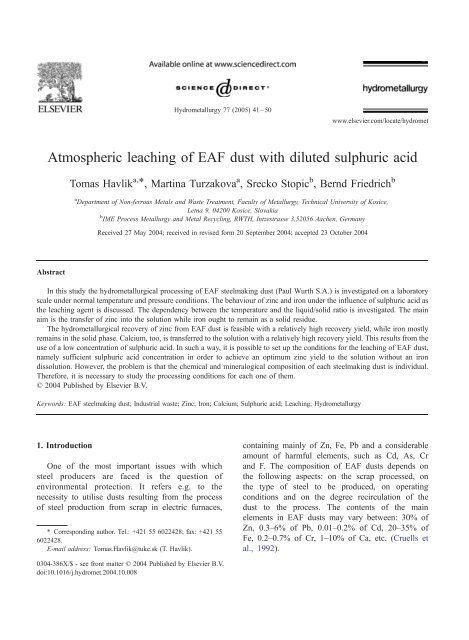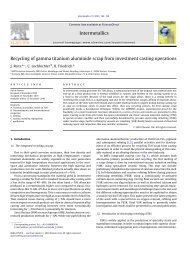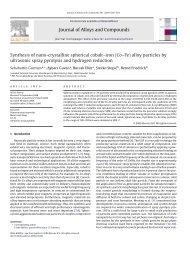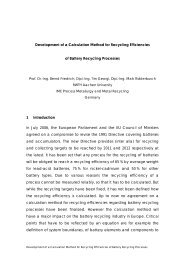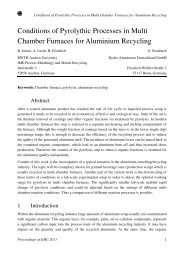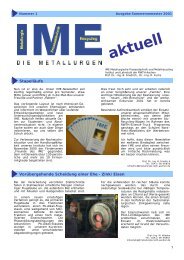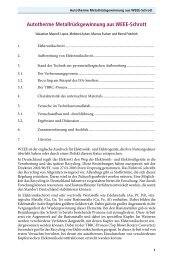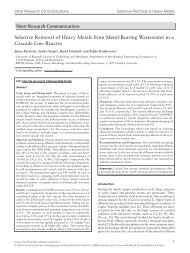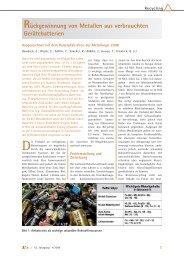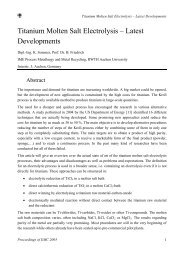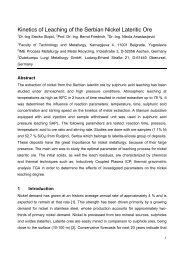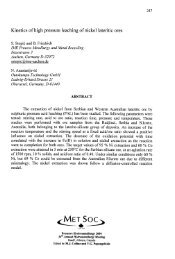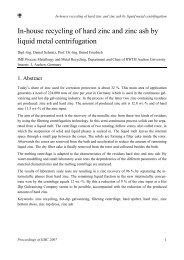Atmospheric leaching of EAF dust with diluted sulphuric acid
Atmospheric leaching of EAF dust with diluted sulphuric acid
Atmospheric leaching of EAF dust with diluted sulphuric acid
- No tags were found...
You also want an ePaper? Increase the reach of your titles
YUMPU automatically turns print PDFs into web optimized ePapers that Google loves.
42T. Havlik et al. / Hydrometallurgy 77 (2005) 41–50The mineralogical analysis indicates the presence <strong>of</strong>iron in an oxide form, mostly as hematite Fe 2 O 3 ,magnetite Fe 3 O 4 and ferrite as franklinite ZnFe 2 O 4 .Zinc is present mostly in two basic compounds, namelyas oxide ZnO and ferrite ZnFe 2 O 4 , and possibly as acomplex ferrite, e.g. (ZnMnFe) 2 O 4 . The mineralogicalform <strong>of</strong> the zinc presence seems to be the basicindicator for the effectiveness <strong>of</strong> the <strong>EAF</strong> <strong>dust</strong> treatment.ZnO in principle is an easily workable form forboth the pyro- and the hydrometallurgical method, butthe ferrite form is considerably complex and difficult.Treatment technologies <strong>of</strong> zinc-bearing wastesrepresent various levels <strong>of</strong> development both <strong>of</strong>pyrometallurgical and hydrometallurgical processes.A brief overview <strong>of</strong> the methods, which have beenused for the treatment <strong>of</strong> this material, was presentedin our previous work (Havlik et al., 2004). Thesea100Table 1Chemical analysis <strong>of</strong> <strong>EAF</strong> <strong>dust</strong> by Paul Wurth S.A.Element Fe Zn Pb Si Ca Mn Cu Cr[%] 27.8 20.9 2.7 2.1 4.3 3.2 0.36 0.77Element Ni Ti Cd Sb As Cl2SO 4 Loss <strong>of</strong>ignition[%] 0.06 ~0.04 0.027 0.069 b0.1 0.89 0 12.18works were made by several investigators (Frenay etal., 1985, 1986; Jha and Duyvesteyn, 1985; Dreissingeret al., 1990; Barrett et al., 1992; McElroy andMcClaren, 1994; McElroy and Murray, 1996; Lupi etal., 1996; Jandová et al., 2002), etc.In study (Havlik et al., 2004), the hydrometallurgicalpressure processing <strong>of</strong> <strong>EAF</strong> steelmaking <strong>dust</strong>,provided by Paul Wurth S.A., Luxembourg, wasinvestigated on a laboratory scale in the temperaturerange <strong>of</strong> 100 to 250 8C. The behaviour <strong>of</strong> zinc, ironMetal extraction [%]80604020Fe extraction; a/d = 1.2Zn extraction; a/d = 1.2b0100100 120 140 160 180 200 220 240 260Temperature [ o C]Metal extraction [%]80604020Fe extraction; a/d = 0.4Zn extraction; a/d = 0.40100 120 140 160 180 200 220 240 260Temperature [ o C]Fig. 1. Metal extraction vs. <strong>leaching</strong> temperature dependence(Havlik et al., 2004). (a) a/d ratio=1.2; (b) a/d ratio=0.4 (a/d=grams<strong>of</strong> concentrated H 2 SO 4 to grams <strong>of</strong> <strong>dust</strong>).Fig. 2. Schematic view <strong>of</strong> the <strong>leaching</strong> apparatus. 1—Stirrer engine;2—propeller; 3—pulp; 4—sampler; 5—thermometer; 6—feeder;7—water seal; 8—water thermostat; 9—<strong>EAF</strong> sample.
T. Havlik et al. / Hydrometallurgy 77 (2005) 41–50 43and calcium under influence <strong>of</strong> <strong>sulphuric</strong> <strong>acid</strong> as the<strong>leaching</strong> agent was discussed.According to the results obtained in this work,the high pressure hydrometallurgical recovery <strong>of</strong> zincfrom <strong>EAF</strong> <strong>dust</strong> is feasible at a reasonable recoveryyield, while iron mostly remains in the solid phase.The latter is due to the use <strong>of</strong> the low concentration <strong>of</strong><strong>sulphuric</strong> <strong>acid</strong> <strong>of</strong> approximately 0.4 mol H 2 SO 4 ddm 3 . Three ratios <strong>of</strong> the free <strong>acid</strong> weight to solid,<strong>with</strong> the value <strong>of</strong> a/d (<strong>acid</strong>/<strong>dust</strong>) <strong>of</strong> 1.2, 0.6, and 0.4,were used. The maximal value <strong>of</strong> selectivity wasobtained by the a/d ratio <strong>of</strong> 0.4. Higher temperaturesand pressures moderately increase the zinc yield.Fig. 1a to b show the results for the metalextraction depending on temperature/pressure anda/d ratios obtained in study (Havlik et al., 2004).These results show promise. However, it isnecessary to compare such results <strong>with</strong> those obtainedby the same hydrometallurgical route but undernormal conditions concerning both temperature andpressure. This is the concept <strong>of</strong> the present study. Themain factors investigated are the effects <strong>of</strong> temperatureon the dissolution <strong>of</strong> Zn, Fe and Ca by use <strong>of</strong><strong>sulphuric</strong> <strong>acid</strong> as the extractant at an atmosphericpressure <strong>of</strong> 0.1 MPa.2. Experimental2.1. MaterialThe materials used in these experiments are thesame as in study (Havlik et al., 2004), i.e. <strong>EAF</strong> <strong>dust</strong>given by Paul Wurth S.A., Luxembourg. Its chemicalanalysis, given in Table 1, was determined by the ICPmethod.aZn extraction [%]706050t = 20 • C; C H2S04 = 0.4 Ma/d = 1.2a/d = 0.6a/d = 0.4bZn extraction [%]706050t = 40 • C; C H2S04 = 0.4 Ma/d = 1.2a/d = 0.6a/d = 0.44040cZn extraction [%]706050400 20 40 60Leaching time [min]a/d = 1.2a/d = 0.6a/d = 0.4t = 60 • C; C H2S04 = 0.4 M0 20 40 60Leaching time [min]dZn extraction [%]706050400 10 20 30 40 50 60 70Leaching time [min]t = 80 • C; C H2S04 = 0.4 MLeaching time [min]a/d = 1.2a/d = 0.6a/d = 0.40 20 40 60Fig. 3. (a) Extraction <strong>of</strong> Zn by <strong>sulphuric</strong> <strong>acid</strong> at a temperature <strong>of</strong> 20 8C. (b) Extraction <strong>of</strong> Zn by <strong>sulphuric</strong> <strong>acid</strong> at a temperature <strong>of</strong> 40 8C. (c)Extraction <strong>of</strong> Zn by <strong>sulphuric</strong> <strong>acid</strong> at a temperature <strong>of</strong> 60 8C. (d) Extraction <strong>of</strong> Zn by <strong>sulphuric</strong> <strong>acid</strong> at a temperature <strong>of</strong> 80 8C.
44T. Havlik et al. / Hydrometallurgy 77 (2005) 41–50The results <strong>of</strong> the X-ray diffraction qualitativeanalysis show the presence <strong>of</strong> compounds such asfranklinite Zn 2 FeO 4 , zincite ZnO, magnetite Fe 3 O 4 ,cristobalite SiO 2 . Other phases, which, on the basis <strong>of</strong>the chemical analysis, could be present, are probablybelow the detection limit.2.2. Experimental set-up and procedureLeaching tests are performed in the apparatus, <strong>of</strong>which a scheme is given in Fig. 2.The <strong>leaching</strong> experiments are performed in a glassreactor <strong>of</strong> 600 mL provided <strong>with</strong> a Teflon cap in thecentral hole in which the axis <strong>of</strong> a glass stirrer foradjustable revolutions is placed. Openings for amercury thermometer, a sampling liquid specimen,and an input <strong>of</strong> the powdered sample are situated inthe perimeter <strong>of</strong> the cap. The reactor is placed in awater bath controlled by a thermostat. This allows toconduct the <strong>leaching</strong> at the desired temperature.Leaching tests are performed <strong>with</strong> a solution <strong>of</strong> 300mL <strong>of</strong> 0.4 M H 2 SO 4 . The sample weight is in therange <strong>of</strong> 10 to 30 g. A solution <strong>with</strong> an <strong>acid</strong>-to-<strong>EAF</strong><strong>dust</strong> ratio a/d <strong>of</strong> between 0.4 and 1.2 is used. Thetemperatures being used are 20, 40, 60, and 80 8C,under normal atmospheric pressure.The samples for the chemical analysis are takenaccording to a fixed-schedule after 2, 15, 30, 45and 60 min. Then the samples are filtered into testtubes and, thus, a clear solution is obtained. Likeduring the pressure <strong>leaching</strong> described in work(Havlik et al., 2004), the solution is colourless,weakly yellow or weakly emerald depending on the<strong>leaching</strong> conditions. In some samples, again theaZn extraction [%]70605040a/d = 1.2, C H2S04 = 0.4 M20 • C40 • C60 • C80 • CbZn extraction [%]70605040a/d = 0.6, C H2S04 = 0.4 M20 • C40 • C60 • C80 • C0 20 40 60Leaching time [min]0 10 20 30 40 50 60 70Leaching time [min]cZn extraction [%]706050a/d = 0.4, C H2S04 = 0.4 M20 • C40 • C60 • C80 • C400 10 20 30 40 50 60 70Leaching time [min]Fig. 4. (a) Extraction <strong>of</strong> Zn by <strong>sulphuric</strong> <strong>acid</strong> for a 10 g charge under various temperatures. (b) Extraction <strong>of</strong> Zn by <strong>sulphuric</strong> <strong>acid</strong> for a 20 gcharge under various temperatures. (c) Extraction <strong>of</strong> Zn by <strong>sulphuric</strong> <strong>acid</strong> for a 30 g charge under various temperatures.
T. Havlik et al. / Hydrometallurgy 77 (2005) 41–50 45white precipitate <strong>of</strong> calcium sulphate appears after 1or 2 days.The chemical analysis, carried out in order todetermine Zn, Fe, and Ca, was made by means <strong>of</strong>an AAS Varian Spectrometer AA 20+. Moreover,the amount <strong>of</strong> free <strong>acid</strong> as well as the pH ismeasured. All results are recalculated because <strong>of</strong>the change <strong>of</strong> the pulp volume due to the samplingand evaporation.3. Results and discussion3.1. Leaching reactionsAs already described in Havlik et al. (2004), thereactions <strong>of</strong> the main species occurring in thesample and their stoichiometry can be stated asfollows:ZnO+H 2 SO 4(aq) YZnSO 4(aq) +H 2 O (1)ZnFe 2 O 4 +4H 2 SO 4(aq) YZnSO 4(aq) +Fe 2 (SO 4 ) 3 +4H 2 O(2)ZnFe 2 O 4 +H 2 SO 4(aq) YZnSO 4(aq) +Fe 2 O 3 +H 2 O (3)CaCO 3 +H 2 SO 4(aq) YCaSO 4 +CO 2 +H 2 O (4)CaO+H 2 SO 4(aq) YCaSO 4 +H 2 O (5)Reaction (2) occurs slowly at room temperature,but runs at a high rate at elevated temperatures.a14 a/d = 1.2t = 20 • C; C a/d = 0.612H2S04 = 0.4 Ma/d = 0.4b1412t = 40 • C; C H2S04 = 0.4 Ma/d = 1.2a/d = 0.6a/d = 0.4Fe extraction [%]10864Fe extraction [%]1086422cFe extraction [%]00 20 40 60Leaching time [min]1412108642t = 60 • C; C H2S04 = 0.4 MLeaching time [min]a/d = 1.2a/d = 0.6a/d = 0.400 20 40 60dFe extraction [%]00 10 20 30 40 50 60 701412108642Leaching time [min]t = 80 • C; C H2S04 = 0.4 MLeaching time [min]a/d = 1.2a/d = 0.6a/d = 0.400 10 20 30 40 50 60 70Fig. 5. (a) Extraction <strong>of</strong> Fe by <strong>sulphuric</strong> <strong>acid</strong> at a temperature <strong>of</strong> 20 8C. (b) Extraction <strong>of</strong> Fe by <strong>sulphuric</strong> <strong>acid</strong> at a temperature <strong>of</strong> 40 8C. (c)Extraction <strong>of</strong> Fe by <strong>sulphuric</strong> <strong>acid</strong> at a temperature <strong>of</strong> 60 8C. (d) Extraction <strong>of</strong> Fe by <strong>sulphuric</strong> <strong>acid</strong> at a temperature <strong>of</strong> 80 8C.
46T. Havlik et al. / Hydrometallurgy 77 (2005) 41–503.2. Leaching studies <strong>with</strong> <strong>sulphuric</strong> <strong>acid</strong>In Fig. 3a to d the extraction curves at 0.4 MH 2 SO 4 and various <strong>acid</strong>/<strong>dust</strong> (a/d) ratios for Zn atdifferent temperatures are presented.The temperature has a considerable effect on theyield <strong>of</strong> the zinc extraction. This is valid for eachsolid/liquid ratio being studied, as demonstrated inFig. 4a to c. Since an increase <strong>of</strong> the quantity <strong>of</strong> thecharge causes the reduction <strong>of</strong> the zinc yield, theconcentration <strong>of</strong> <strong>sulphuric</strong> <strong>acid</strong> (or the a/d ratio)seems to be the second important factor for the zincextraction. The maximum value for the zincextraction <strong>of</strong> 67% is obtained at a temperature <strong>of</strong>80 8C, in a time <strong>of</strong> 60 min and <strong>with</strong> a concentration<strong>of</strong> <strong>sulphuric</strong> <strong>acid</strong> <strong>of</strong> 0.4 mold dm 3 (Fig. 3d).However, the curves in general show a progressiverun. This means that the prolongation <strong>of</strong> the<strong>leaching</strong> time should result in an increase <strong>of</strong> zincextraction.Fig. 5a to d illustrate the extraction curves for ironunder the same conditions. In these cases, the increase<strong>of</strong> temperature causes the increase <strong>of</strong> the iron yield,although the total amount <strong>of</strong> iron in the solution doesnot exceed 10%.The temperature effect on iron extraction is shownin Fig. 6a to c at various a/d ratio. It was observed inthe high temperature/pressure <strong>leaching</strong> <strong>of</strong> <strong>EAF</strong> <strong>dust</strong>(Havlik et al., 2004) that calcium sulphate wasprecipitated from the same solution after the <strong>leaching</strong>and cooling <strong>of</strong> the <strong>leaching</strong> solution. In the presentexperiments, under normal conditions concerningboth temperature and pressure the white precipitate<strong>of</strong> calcium sulphate rarely occurs. Fig. 7a to ddemonstrate the extraction <strong>of</strong> the calcium during the<strong>leaching</strong> under various conditions.aFe extraction [%]14 20 • C12a/d = 1.2, C H2S04 = 0.4 M20 • C20 • C20 • C10864200 10 20 30 40 50 60 70Leaching time [min]cFe extraction [%]1412108642bFe extraction [%]14121000 20 40 60864220 • C20 • C20 • C20 • C20 • C20 • C20 • C20 • C00 10 20 30 40 50 60 70Leaching time [min]a/d = 0.4, C H2S04 = 0.4 MLeaching time [min]a/d = 0.6, C H2S04 = 0.4 MFig. 6. (a) Extraction <strong>of</strong> Fe by <strong>sulphuric</strong> <strong>acid</strong> for 10 g charge under various temperatures. (b) Extraction <strong>of</strong> Fe by <strong>sulphuric</strong> <strong>acid</strong> for 20 g chargeunder various temperatures. (c) Extraction <strong>of</strong> Fe by <strong>sulphuric</strong> <strong>acid</strong> for a 30 g charge under various temperatures.
T. Havlik et al. / Hydrometallurgy 77 (2005) 41–50 47a40b40Ca extraction [%]302010t = 20 • C; C H2S04 = 0.4 Ma/d = 1.2a/d = 0.6a/d = 0.4Ca extraction [%]302010a/d = 1.2a/d = 0.6a/d = 0.4cCa extraction [%]00 10 20 30 40 50 60 70Leaching time [min]40302010a/d = 1.2a/d = 0.6a/d = 0.4dCa extraction [%]t = 40 • C; C H2S04 = 0.4 M00 10 20 30 40 50 60 7040302010Leaching time [min]t = 80 • C; C H2S04 = 0.4 Ma/d = 1.2a/d = 0.6a/d = 0.4t = 60 • C; C H2S04 = 0.4 M00 20 40 60Leaching time [min]00 10 20 30 40 50 60 70Leaching time [min]Fig. 7. (a) Extraction <strong>of</strong> Ca by <strong>sulphuric</strong> <strong>acid</strong> at a temperature <strong>of</strong> 20 8C. (b) Extraction <strong>of</strong> Ca by <strong>sulphuric</strong> <strong>acid</strong> at a temperature <strong>of</strong> 40 8C. (c)Extraction <strong>of</strong> Ca by <strong>sulphuric</strong> <strong>acid</strong> at a temperature <strong>of</strong> 60 8C. (d) Extraction <strong>of</strong> Ca by <strong>sulphuric</strong> <strong>acid</strong> at a temperature <strong>of</strong> 80 8C.Although the amount <strong>of</strong> dissolved calcium is ratherhigh, it is considerably decreased by the increase <strong>of</strong>the charge, as it is demonstrated in Fig. 8a toc.The concentration <strong>of</strong> H 2 SO 4 used for these experiments,i.e. 0.4 mold dm 3 , results from previousexperiments described in study (Havlik et al., 2004).The thermodynamic considerations and calculationsreveal that this concentration should mostly be spentfor the dissolution <strong>of</strong> zinc, but less for iron andcalcium. Fig. 9 shows the <strong>acid</strong> consumption during<strong>leaching</strong>, determined as the dependence <strong>of</strong> the pHvalueon the charge amount at various temperatures.The results reveal that the a/d ratio, i.e. the chargeamount, plays an important role in the metalextraction. pH values were increased according tothe increase <strong>of</strong> the a/d ratio due to a higherconsumption <strong>of</strong> <strong>sulphuric</strong> <strong>acid</strong> during <strong>leaching</strong>. Sincesmall charges are used, the zinc extraction is considerablyhigh. The maximum value for zinc extractiona=67% is obtained at a temperature <strong>of</strong> 80 8C, in a time<strong>of</strong> 60 min and at a used concentration <strong>of</strong> <strong>sulphuric</strong><strong>acid</strong> <strong>of</strong> 0.4 mold dm 3 , Figs. 3d and 4a. A furtherincrease <strong>of</strong> the <strong>leaching</strong> time would probably result insame zinc extraction increasing as follows from Figs.3d and 4a.The increase <strong>of</strong> the charge amount results in thedecreasing <strong>of</strong> the zinc extraction. In these cases,however, temperature plays a less important role. Thisprobably means that the <strong>sulphuric</strong> <strong>acid</strong> concentrationis a limiting factor for the dissolution <strong>of</strong> zinc.This applies to iron and calcium, too. Themaximum <strong>of</strong> iron dissolved is less than 10%, (Figs.5d and 6a), but in case <strong>of</strong> calcium it is up to 40%(Figs. 7d and 8a).Comparing <strong>of</strong> the results obtained in this work <strong>with</strong>those obtained in the study <strong>of</strong> high temperature/
48T. Havlik et al. / Hydrometallurgy 77 (2005) 41–50aCa extraction [%]4030202010• C40 • Ca/d = 1.2, C H2S04 = 0.4 M60 • C80 • C00 10 20 30 40 50 60 70Leaching time [min]cCa extraction [%]40302010bCa extraction [%]40302010a/d = 0.4, C H2S04 = 0.4 Ma/d = 0.6, C H2S04 = 0.4 M00 10 20 30 40 50 60 70Leaching time [min]20 • C40 • C60 • C80 • C20 • C40 • C60 • C80 • C0010 20 30 40 50 60 70Leaching time [min]Fig. 8. (a) Extraction <strong>of</strong> Ca by <strong>sulphuric</strong> <strong>acid</strong> for a 10 g charge under various temperatures. (b) Extraction <strong>of</strong> Ca by <strong>sulphuric</strong> <strong>acid</strong> for a 20 gcharge under various temperatures. (c) Extraction <strong>of</strong> Ca by <strong>sulphuric</strong> <strong>acid</strong> for a 30 g charge under various temperatures.pressure <strong>leaching</strong> (Havlik et al., 2004) under similarconditions shows that the <strong>leaching</strong> under normalconditions results in the lower extraction <strong>of</strong> zinc, evenpH1.81.61.41.21.00.80.620 • C40 • C0.460 • C80 • C0.25 10 15 20 25 30 35grams <strong>of</strong> charge [g]Fig. 9. pH vs. charge amount dependence for various temperatures.though there is the tendency for the further dissolution<strong>of</strong> zinc. In high temperature/pressure <strong>leaching</strong> the<strong>leaching</strong> ceases after a short time at a fixed value. Themaximum value is, at best, at a=84%.Furthermore, in regard to iron, the study showsthat the maximum value <strong>of</strong> iron dissolved undernormal <strong>leaching</strong> conditions is about 10%, in contrastto high temperature/pressure <strong>leaching</strong> in which, atthe worst, more than 20% is achieved. In hightemperature/pressure <strong>leaching</strong> at best around 1% <strong>of</strong>dissolved iron is achieved. Under normal <strong>leaching</strong>conditions, regarding both temperature and pressure,the minimum value for the iron dissolution is about2%.The quantity <strong>of</strong> dissolved calcium is rather high.With a <strong>sulphuric</strong> <strong>acid</strong> concentration <strong>of</strong> 0.4 mold dm 3 ,only in one case the white precipitate <strong>of</strong> calciumsulphate is formed. However, this only applies fortemperatures <strong>of</strong> 100 and 150 8C (concerning high
T. Havlik et al. / Hydrometallurgy 77 (2005) 41–50 49aMetal extraction [%]80604020Zn extraction; a/d = 1.2Fe extraction; a/d = 1.2bMetal extraction [%]80604020Zn extraction; a/d = 0.4Fe extraction; a/d = 0.4020 40 60 80Temperature [ • C]020 40 60 80Temperature [ • C]Fig. 10. (a) Dependency <strong>of</strong> metal extraction vs. <strong>leaching</strong> temperature at a/d=1.2. (b) Dependency <strong>of</strong> metal extraction vs. <strong>leaching</strong> temperature ata/d=0.4.temperature/pressure <strong>leaching</strong>). This is the reason thatonly a small amount <strong>of</strong> calcium remains in the solution.Fig. 10a to b show the dependencies <strong>of</strong> metalextraction on the <strong>leaching</strong> temperature for the highestand lowest <strong>dust</strong> charge, each in relation to theamount <strong>of</strong> <strong>acid</strong> available for the <strong>leaching</strong>. For thelowest charge amount <strong>of</strong> a/d=1.2, the zinc extractionis higher having the tendency to increase at a highertemperature. Yet, when using the lowest chargeamount, also the quantity <strong>of</strong> the dissolved iron ishigher compared to a/d=0.4. The comparison <strong>with</strong>the experiment at 100 8C, presented in work (Havliket al., 2004), reveals that this, under normal temperature/pressureconditions, is the optimum temperaturefor the maximal zinc extraction. However, theamount <strong>of</strong> extracted iron is several times higher at100 8C than at 80 8C. It seems that higher values <strong>of</strong>selectivity are obtained by lower temperature and,perhaps, a/d ratios.4. ConclusionAccording to the results obtained in this work, thehydrometallurgical recovery <strong>of</strong> zinc from <strong>EAF</strong> <strong>dust</strong> isfeasible <strong>with</strong> a relatively high recovery yield, whileiron mostly stays in solid phase. A similar conclusioncan be drawn in the case <strong>of</strong> high temperature/pressure<strong>leaching</strong> under equivalent experimental conditions.Comparing the results <strong>of</strong> this work <strong>with</strong> thoseobtained by high temperature/pressure <strong>leaching</strong> manifestthat, concerning the zinc extraction, the last ismore effective. Yet, this does not relate to iron.Additionally, calcium permanently remains in thesolution. Although in high temperature/pressure<strong>leaching</strong> calcium is dissolved first, it later precipitatesas calcium sulphate. This does only relate to temperaturesup to 150 8C and pressures up to 4.1 bar. Evenin higher temperatures/pressures <strong>leaching</strong> calciumpermanently remains in the solution. This behaviourresults from using a low concentration <strong>of</strong> <strong>sulphuric</strong><strong>acid</strong>. This also causes in fact a decrease in the zincyield, yet the amount <strong>of</strong> dissolved iron is low. In sucha way, it can be possible to set up the conditions for anoptimum zinc yield into the solution <strong>with</strong> a minimisediron dissolution. However, the problem persists thatthe chemical and mineralogical composition <strong>of</strong> eachsteelmaking <strong>dust</strong> is individual and that for each onethe conditions <strong>of</strong> processing have to be studied.AcknowledgementThe authors wish to express their gratitude toSlovak grant agency VEGA (Grant 1/9379/02) forfinancial support.ReferencesBarrett, E.C., Nenniger, E.H., Dziewinski, J., 1992. A hydrometallurgicalprocess to treat carbon steel electric arc furnace<strong>dust</strong>. Hydrometallurgy (30), 59–68.
50T. Havlik et al. / Hydrometallurgy 77 (2005) 41–50Cruells, M., Roca, A., Nunez, C., 1992. Electric arc furnace flue<strong>dust</strong>s: characterization and <strong>leaching</strong> <strong>with</strong> <strong>sulphuric</strong> <strong>acid</strong>. Hydrometallurgy31, 213–231.Dreissinger, D.B., Peters, E., Morgan, G., 1990. The hydrometallurgicaltreatment <strong>of</strong> carbon steel electric arc <strong>dust</strong> by theUBC-Chaparral process. Hydrometallurgy (25), 137–152.Frenay, J., Hissel, J., Ferlay, S., 1985. Recovery <strong>of</strong> lead and zincfrom electric steelmaking <strong>dust</strong>s by the Cebedeau process. Met.Soc. AIME, 195–208.Frenay, J., Ferlay, S., Hissel, J., 1986. Zinc and lead recovery from<strong>EAF</strong> <strong>dust</strong>s by caustic soda process. Electric Furnace Proc.,Treatment Options for Carbon Steel Electric Arc Furnace Dust,Iron and Steel Soc., vol. 43, pp. 171–175.Havlik, T., Friedrich, B., Stopić, S., 2004. Pressure <strong>leaching</strong> <strong>of</strong> <strong>EAF</strong><strong>dust</strong> <strong>with</strong> <strong>sulphuric</strong> <strong>acid</strong>. Erzmetall 57 (2), 113–120.Jandová, J., Dvorak, P., Vu, H., 2002. Recovery <strong>of</strong> magnetite andzinc from steelmaking <strong>dust</strong> by H 2 SO 4 <strong>leaching</strong>. Recycling andWaste Treatment in Mineral and Metal Processing, June 2002,Lulea Sweden, pp. 251–259.Jha, M.C., Duyvesteyn, W.P.C., 1985. A two-stage <strong>leaching</strong> processfor selective recovery <strong>of</strong> zinc from steel plant <strong>dust</strong>s. In: Taylor,P.R., Sohn, H.Y., Jarret, N. (Eds.), Proc. Recycling andSecondary Recovery <strong>of</strong> Metals, Met. Soc. AIME, pp. 143–157.Lupi, C., Pilone, D., Cavallini, M., 1996. Hydrometallurgicalprocessing <strong>of</strong> <strong>EAF</strong> steelmaking fumes. In: Ramachandran, V.,Nesbitt, C.C. (Eds.), Proc. Extraction and Processing for theTreatment and Minimisation <strong>of</strong> Wastes, TMS, pp. 711 – 718.McElroy, R.O., McClaren, M., 1994. Processing <strong>of</strong> electric arcfurnace <strong>dust</strong> via chloride hydrometallurgy. Proc. Hydrometallurgy’94, IMM. Chapman & Hall, pp. 993–1010.McElroy, R.O., Murray, W., 1996. Developments in the Terra Gaiaprocess for the treatment <strong>of</strong> <strong>EAF</strong> <strong>dust</strong>. In: Dutrizac, J.E., Harris,G.B. (Eds.), Iron Control and Disposal. Canadian Inst. <strong>of</strong> Min.,Met., and Petroleum, Montreal, Canada, pp. 39–44.


